 本文由 创作,已纳入「FreeBuf原创奖励计划」,未授权禁止转载
本文由 创作,已纳入「FreeBuf原创奖励计划」,未授权禁止转载
0x00 前言
在目标资产梳理的过程中,总能遇到一些IP的Whois信息中存在与目标的关联。
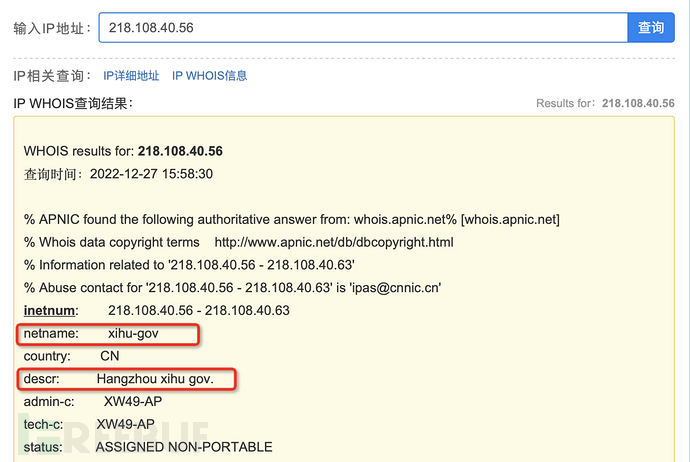
例如上图中218.108.40.56属于218.108.40.56 - 218.108.40.63,整个段的网络名称为xihu-gov,描述为Hangzhou xihu gov,根据这个描述和名称推测与之相关联的极有可能是杭州市西湖区人民zf。
这种关联给了我们另一种寻找目标资产的思路,即通过一定的手段处理目标资产名称为关键词,在数据库中查找与之相关联的IP段。但我在网络中没有寻找到适合红队进行此类资产梳理的工具(应该是我菜没错了),决定自己动手。
不想看过程的师傅们可直接在下边下载工具用。
工具(开源)与数据库下载:https://github.com/SleepingBag945/IPSearch
总共两个功能,根据IP查询所属IP段信息、根据关键词查询IP段信息。
若是师傅们喜欢此工具,给个star呗?
0x01 数据来源
要进行IP Whois信息的查询,首先得知道从哪里获取这些信息,通过搜索引擎一把梭得知:
IP地址的划分,有RIR机构来进行统筹管理。负责亚洲地区IP地址分配的,就是APNIC,总部位于澳大利亚墨尔本。 各大RIR机构都提供了关于IP地址划分的登记信息,即whois记录。
APNIC提供了每日更新的亚太地区IPv4,IPv6,AS号分配的信息表,访问url是
http://ftp.apnic.net/apnic/stats/apnic/delegated-apnic-latest
向上级目录访问,并浏览一番后得知
http://ftp.apnic.net/apnic/whois/apnic.db.inetnum.gz
http://ftp.apnic.net/apnic/whois/apnic.db.inet6num.gz
这里存放着亚洲地区所有IP地址段信息。
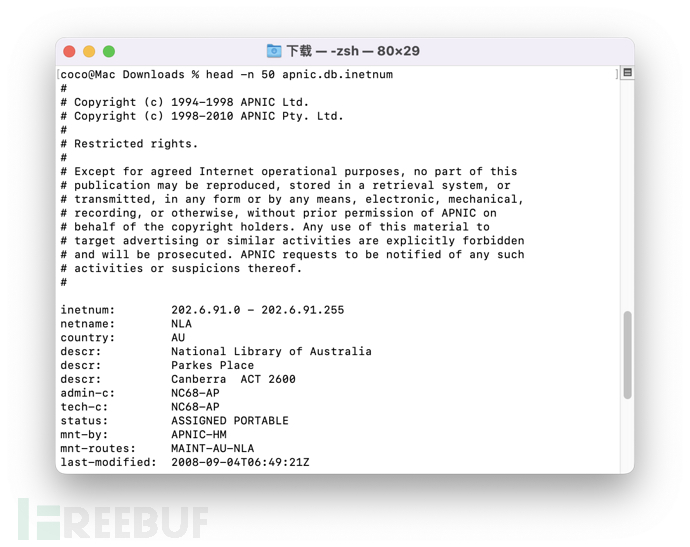
那这就很方便了,免除了编写爬虫的过程,只需要读取下载的文件进行解析即可。
0x02 数据解析
解压后的apnic.db.inetnum文件有足足500m,直接对文本文件进行检索性能绝对有问题,那就需要对数据进行解析后存进数据库,在对数据库进行检索。为了方便到处跑,这里选自包含的、无服务的、零配置的sqlite3数据库
既然要存数据库,那必然得建表,这里写了个小脚本统计到底有多少像这样的列。

inetnums = []
with open("apnic.db.inetnum","rb") as f:
inetnums = f.read().split(b"\n")
result = []
for line in inetnums:
if b": " in line:
key = line.split(b":")[0]
if key not in result:
result.append(key)
for each in result:
print(each.decode("UTF-8"))
inetnum
netname
country
descr
admin-c
tech-c
status
mnt-by
mnt-routes
last-modified
source
remarks
org
abuse-c
mnt-lower
mnt-irt
geoloc
language
主键就以inetnum中的ip段的起始ip的十进制数字形式存储为start字段,ip段结束ip存储为end字段,而不是以字符串形式存储ip段,这样会方便搜索ip属于哪个ip段。
为了方便搜索ip属于哪个ip段,这里添加ip段的起始ip的十进制数字形式存储为start字段,ip段结束ip为end字段。
一个IP段中可能存在多个descr,那么可以将多个重复项通过空格合并写入数据库的统一列,不影响数据搜索。
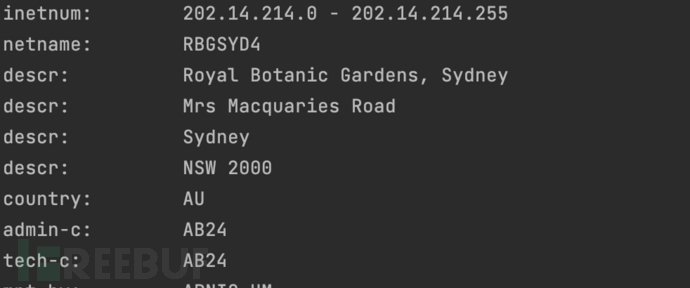
这就可以建表了,建表语句如下
CREATE TABLE "ipseg" (
"start" INTEGER NOT NULL COLLATE BINARY,
"end" INTEGER NOT NULL,
"inetnum" TEXT NOT NULL UNIQUE,
"netname" TEXT,
"country" TEXT,
"descr" TEXT,
"admin-c" TEXT,
"tech-c" TEXT,
"status" TEXT,
"mnt-by" TEXT,
"mnt-routes" TEXT,
"last-modified" TEXT,
"source" TEXT,
"remarks" TEXT,
"org" TEXT,
"abuse-c" TEXT,
"mnt-lower" TEXT,
"mnt-irt" TEXT,
"geoloc" TEXT,
"language" TEXT,
PRIMARY KEY("inetnum")
);
再写一个小脚本负责解析并导入sqlite
import sqlite3
import IPy
whoisinfo = []
def analysis_whois(whois_str):
start = 0
end = 0
inetnum = ""
netname = ""
country = ""
descr = ""
admin_c = ""
tech_c = ""
status = ""
mnt_by = ""
mnt_routes = ""
last_modified = ""
source = ""
remarks = ""
org = ""
abuse_c = ""
mnt_lower = ""
mnt_irt = ""
geoloc = ""
language = ""
for _line in whois_str.split(b"\n"):
if _line == b"":
continue
line = _line.decode(encoding='UTF-8',errors='ignore')
line = line.replace("\"","")
if "inetnum:" in line:
inetnum = line.split(":")[1].strip()
#print(inetnum)
if " - " not in inetnum:
continue
ip = inetnum.split(" - ")
start = int(IPy.IP(ip[0]).strDec())
end = int(IPy.IP(ip[1]).strDec())
elif "netname:" in line:
netname = line.replace("netname:","").strip()
elif "country:" in line:
country = line.replace("country:", "").strip()
elif "descr:" in line:
descr += line.replace("descr:", "").strip() + " "
elif "admin-c:" in line:
admin_c += line.replace("admin-c:", "").strip() + " "
elif "tech-c:" in line:
tech_c += line.replace("tech-c:", "").strip() + " "
elif "status:" in line:
status += line.replace("status:", "").strip() + " "
elif "mnt-by:" in line:
mnt_by += line.replace("mnt-by:", "").strip() + " "
elif "mnt-routes:" in line:
mnt_routes += line.replace("mnt-routes:", "").strip() + " "
elif "last-modified:" in line:
last_modified += line.replace("last-modified:", "").strip() + " "
elif "source:" in line:
source += line.replace("source:", "").strip() + " "
elif "remarks:" in line:
remarks += line.replace("remarks:", "").strip() + " "
elif "org:" in line:
org += line.replace("org:", "").strip() + " "
elif "abuse-c:" in line:
abuse_c += line.replace("abuse-c:", "").strip() + " "
elif "mnt-lower:" in line:
mnt_lower += line.replace("mnt-lower:", "").strip() + " "
elif "mnt-irt:" in line:
mnt_irt += line.replace("mnt-irt:", "").strip() + " "
elif "geoloc:" in line:
geoloc += line.replace("geoloc:", "").strip() + " "
elif "language:" in line:
language += line.replace("language:", "").strip() + " "
if " - " not in inetnum or "." not in inetnum:
return
sql = """INSERT INTO ipseg(start,end,inetnum,netname,country,descr,"admin-c","tech-c",status,"mnt-by","mnt-routes","last-modified",source,remarks,org,"abuse-c","mnt-lower","mnt-irt",geoloc,language) VALUES ( """ + "\"{}\","*19 + "\"{}\" )"
sql = sql.format(start,end,inetnum,netname,country,descr[:-1],admin_c[:-1],tech_c[:-1],status[:-1],mnt_by[:-1],mnt_routes[:-1],last_modified[:-1],source[:-1],remarks[:-1],org[:-1],abuse_c[:-1],mnt_lower[:-1],mnt_irt[:-1],geoloc[:-1],language[:-1])
try:
conn.execute(sql)
except BaseException as e:
print(inetnum,"error",e,descr)
conn = sqlite3.connect("IP.db")
with open("apnic.db.inetnum","rb") as f:
whoisinfo = f.read().split(b"\n\n")
count = 0
for info in whoisinfo:
analysis_whois(info)
if count % 1000 == 0:
conn.commit()
count += 1
conn.close()
代码看着比较笨,但运行后看起来效果还不戳。
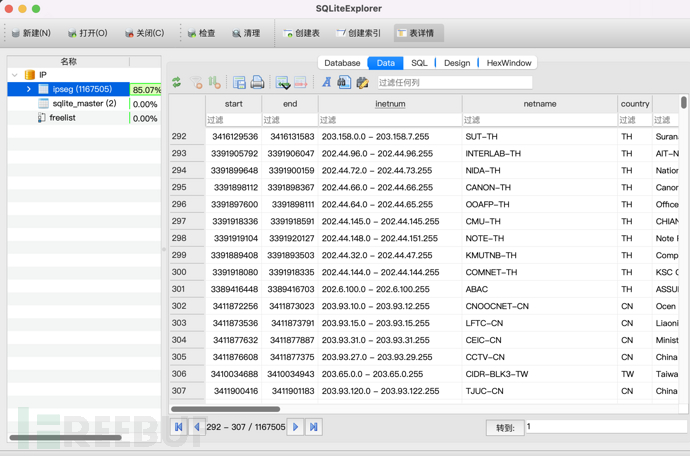
不想麻烦的师傅们可以直接进github的Release找到IP.zip下载。
数据库有了,接下来就是查询工具的实现。
语言方面我选择能一次编码到处运行的Golang。
0x03 IP查询IP段
在线版IPwhois
http://ip.webmasterhome.cn/ipwhois.asp?ip=1.1.1.1
这个功能是为了实现IPWhois的离线版,解决在线查询目标资产大量IP会比较慢,也会给服务器造成负担的问题。
前边建表的时候为了方便此功能,增加了start与end字段,这时候该派上用场了。

比如我要搜索222.222.222.222的IP段信息,转换得到十进制IP为3739147998,那就搜索start比这个小于等于,end比这个大于等于的ip段。
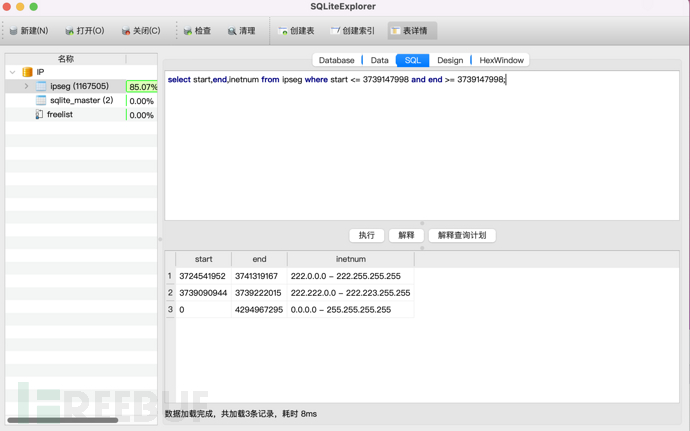
出现了三个包含目标的IP段,选范围最小最精细的。那就用end-start排序一下,最后只输出最小的那个。

最终sql语句与代码如下
select inetnum,netname,country,descr,status,"last-modified" from ipseg where start <= 3739147998 and end >= 3739147998 order by end-start ASC limit 0,1;
func queryInfoByIP(ip int, db *sql.DB) {
var inetnum string
var netname string
var country string
var descr string
var status string
var last_modified string
query := "select inetnum,netname,country,descr,status,\"last-modified\" from ipseg where start <= %d and end >= %d order by end-start ASC limit 0,1;"
query = fmt.Sprintf(query, ip, ip)
rows, err := db.Query(query)
if err != nil {
log.Fatal(err)
}
defer rows.Close()
for rows.Next() {
err = rows.Scan(&inetnum, &netname, &country, &descr, &status, &last_modified)
if err != nil {
log.Fatal(err)
}
}
fmt.Println("IP段:", inetnum)
fmt.Println("名称:", netname)
fmt.Println("描述:", descr)
fmt.Println("国家:", country)
fmt.Println("状态:", status)
fmt.Println("最后修改:", last_modified)
}
0x04 关键词查询IP段
一般与目标名称关联的信息在descr与netname中,只要信息中出现关键词即可输出。
sql语句很简单。
select inetnum,netname,descr from ipseg where descr like "%key%" or netname like "%key%";
多个key查询只需要稍稍构造下sql语句。
func queryInfoByKey(keys []string, db *sql.DB) {
query := "select inetnum,netname,descr from ipseg where "
descrQuery := "("
for _, key := range keys {
descrQuery += fmt.Sprintf("descr like \"%%%s%%\" and ", key)
}
descrQuery = descrQuery[:len(descrQuery)-5] + ") "
query += descrQuery
query += "or "
netnameQuery := "("
for _, key := range keys {
netnameQuery += fmt.Sprintf("netname like \"%%%s%%\" and ", key)
}
netnameQuery = netnameQuery[:len(netnameQuery)-5] + ")"
query += netnameQuery + ";"
rows, err := db.Query(query)
if err != nil {
log.Fatal(err)
}
defer rows.Close()
count := 0
for rows.Next() {
var inetnum string
var netname string
var descr string
err = rows.Scan(&inetnum, &netname, &descr)
if err != nil {
log.Fatal(err)
}
count += 1
fmt.Println("序号:", count)
fmt.Println("IP段:", inetnum)
fmt.Println("名称:", netname)
fmt.Println("描述:", descr, "\n")
// 限制数量
if count > 2000 {
break
}
}
}
搜开头对应的西湖人民zf IP段就直接这么调用
queryInfoByKey([]string{"xihu", "gov"}, db)

可见还是可以获取到目标IP段的,但会有奇怪的东西混进来,需要人工筛选。
0x05 使用场景
演练中用户收集目标信息、拓展攻击面。
拿到目标名称为杭州市西湖区人民zf后,根据西湖可查询xihu,人民zf可查询gov,合并为xihu,gov.
使用IPSearch直接搜索相关IP段。
coco@Mac IPSearch % ./IPSearch -k xihu,gov
序号: 1
IP段: 218.108.40.56 - 218.108.40.63
名称: xihu-gov
描述: Hangzhou xihu gov.
序号: 2
IP段: 222.133.244.192 - 222.133.244.207
名称: LCZFXXH
描述: liaochenggovermentxinxihua
序号: 3
IP段: 61.164.41.224 - 61.164.41.255
名称: XIHU-GOV-INFORMATION-CENTER
描述: XIHU District government Information Center
序号: 4
IP段: 58.241.40.64 - 58.241.40.127
名称: XINXIHUABANGONGSHI-GOV
描述: XINXIHUABANGONGSHI-GOV,WUXI,JIANGSU PROVINCE
序号: 5
IP段: 115.238.92.224 - 115.238.92.239
名称: HZ-XIHU
描述: The people's government of Hangzhou City,Xihu District
可以得到五个结果,通过对描述的详细观察,序号为1,5的IP段内的IP极大概率为杭州市西湖区人民zf的资产。
代替C段拓展IP
演练中收集到一个与目标关联的IP,也许会查看当前IP下的所有资产是否与目标有关,但这个C段范围也许太大了,很可能耗费大量时间却打偏了。但将收集到的ip塞入IPSearch工具查询,通过ip信息查找相同段的资产,再看描述先过滤一次能降低日偏的风险,节约宝贝的攻击时间。





